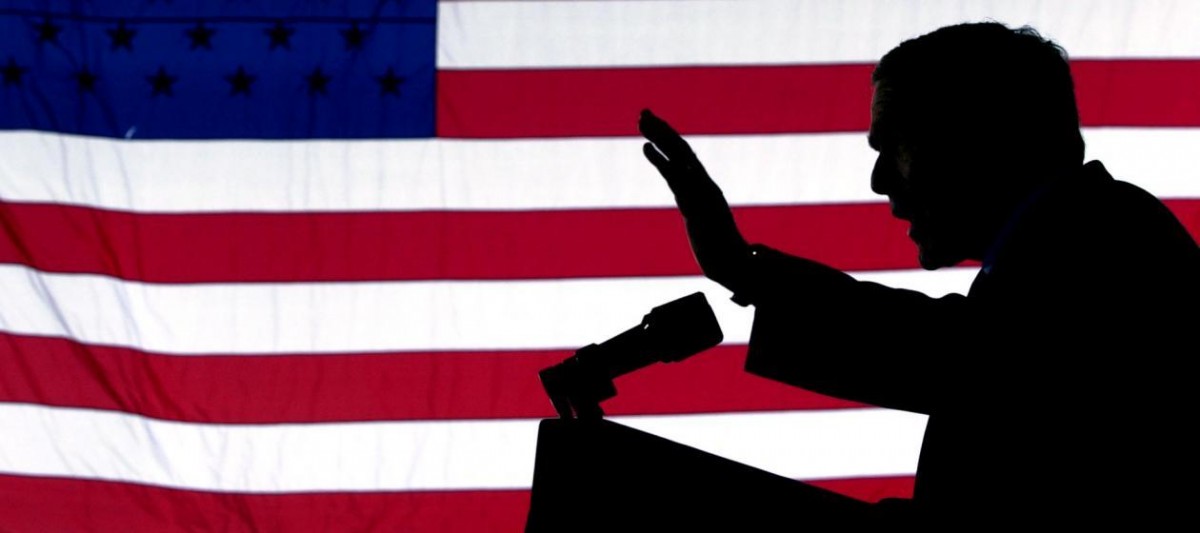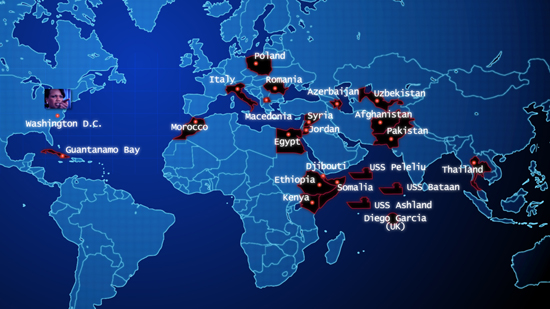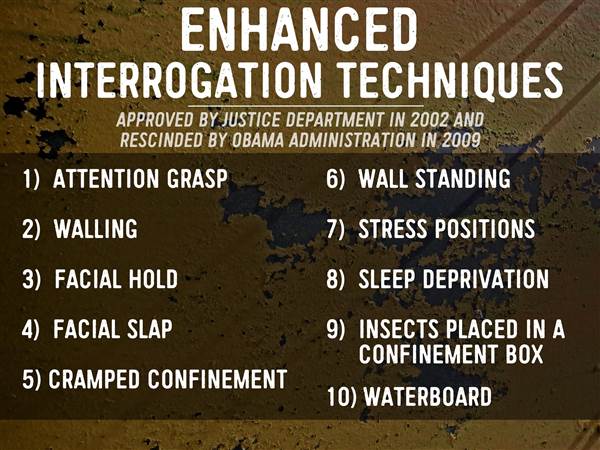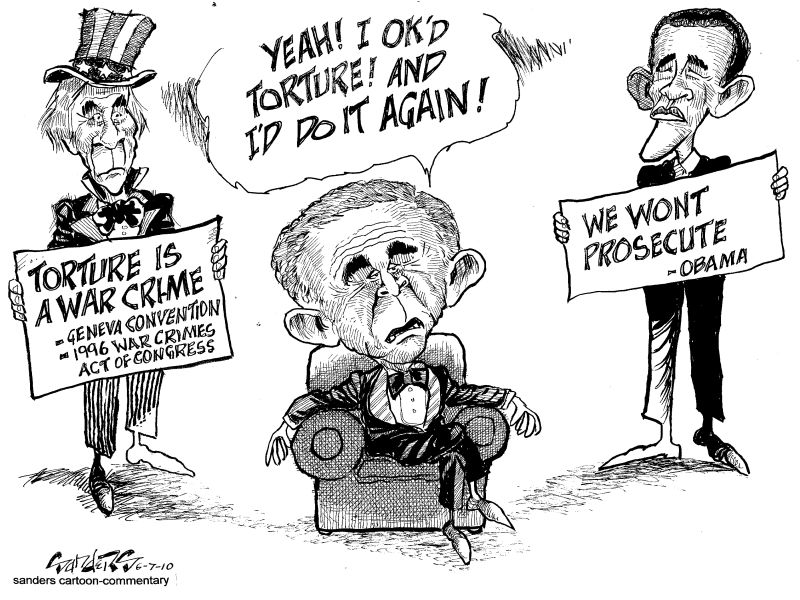
Witnesses Against Torture’s annual week of actions in Washington DC [Credit: Witnesses Against Torture]
Katie Fong
The interest for this project stems from my fascination with human psychology and the decision-making process. While learning about the commodification process in the program Commodities, Conflict, and Cooperation, I found myself constantly questioning people’s actions and the reasoning that might be found behind them. Why did people do the things they did in their pursuits of profit? What were people willing to sacrifice or overlook for capital gain? With this project I attempt to explore these questions further.
Psychology is the scientific study of the human mind and its functions, especially those affecting behavior (Oxford Dictionary). The sciences generally hold a very high value in our society. Science is often seen as an ultimate truth so some might be less likely to question an action that has scientific justification. In this project I will research the role of sciences in capitalism. The specific example I will be focusing on is the use of psychology to justify the use of torture under the George W. Bush administration. I will also explore the effects that capitalism can have on a science when the motivation is profit-based.

George W. Bush was president from January 20, 2001 to January 20, 2009. During his presidency, Bush launched the United States into the Iraq War of 2003-11. The Iraq War was the most expensive war, costing the United States over $600 billion, almost three times as much as the second most expensive war, World War II (Daggett). The War on Terror, not to be confused with the Iraq War, was a response by the Bush administration to the terrorist attacks on September 11, 2001.
The War on Terror launched the United States’ special forces into uncharted territory. A new kind of enemy was believed to require a new approach when it came to enemy interrogation. One well known example of “torture gone wrong” was the case of Abu Zubaydah. After September 11, an al Qaeda operative named Abu Zubaydah was captured in Pakistan after a shoot-out (Clark). At the time, the C.I.A. had very little experience with interrogation so the FBI was brought in. A highly experienced Muslim interrogator who spoke Arabic, Ali Soufan, took charge of the questioning. He used the traditional police model, which focuses on building rapport and a criminal case. With Soufan’s method, Zabaydah gave up useful information almost immediately (Cooper). Despite Soufan’s success and expertise, he was replaced with a Dr. James Mitchell, a psychologist who had no experience with Islamist extremism or al Qaeda, did not speak Arabic, and had zero interrogation experience (Cooper).
“That is the level of competence the Bush administration was willing to flush down the toilet to validate its iron belief that non-violent interrogations (soft, weak, liberal) could never work, despite Soufan’s proven success” (Cooper).


The initial involvement of James Mitchell and Bruce Jessen in the C.I.A. torture program raises some suspicion. Both men were psychologists with zero interrogation experience. The C.I.A. did not actively seek the men out, instead the two played a role in convincing the C.I.A. to adopt coercive interrogation techniques (Tanfani & Hennigan). The inspiration for the techniques used in the new interrogation methods were inspired by the S.E.R.E. (Survival, Evasion, Resistance, and Escape) school. Jessen was the chief psychologist for the Air Force’s S.E.R.E. program. It was at this program that U.S. airmen were trained how to resist and survive if they were captured by countries that did not follow the Geneva Convention (Tanfani & Hennigan). James Mitchell was also also a former member of the United States Air Force.
“In the frantic days following September 11, high-ranking officers in the Pentagon sought advice of the psychologists whether sleep deprivation, stripping, and stress positions – part of the courses to prepare downed airmen – could instead be used to break resistance of terrorism suspects and extract vital information on future threats.” (Tanfani & Hennigan). Defense Department lawyers also asked Jessen’s military unit for advice on “exploitation” of prisoners (Tanfani & Hennigan).
An officer of the Joint Personnel Recovery Agency stated “I believe our niche lies in the fact that we can now provide the ability to exploit personnel based on how our enemies have done this thing over the last five decades” (Tanfani & Hennigan).
The C.I.A. interrogation program was developed “on the fly” in response to the capture of Zubaydah. The C.I.A. was incredibly unprepared to run a detention and interrogation program (Tanfani & Hennigan). Jessen and Mitchell were literally writing the rules as they went. Torture techniques were authorized after they had already been used. To cover the administration legally, there were loopholes embedded in the torture memos – “detainees to be treated humanely to the extent appropriate and consistent with military necessity” (Fontas).

One of the main questions that revolves around the Bush administration’s torture policy is: Why did the U.S. end up torturing detainees during the War on Terror? There was no scientific proof that coercive interrogations would yield valuable intelligence, and ample proof that it would harm our national security interests, elicit false information, and spread unnecessary ill will throughout the Muslim world. In the case of Abu Zubaydah, the use of coercive interrogation resulted in no additional information. Zubaydah spoke freely to the FBI interrogator and provided extensive info on al Qaeda activities, plans, capabilities, and structure (Tanfani & Hennigan).
In August 2002, Zubaydah’s torture began in Cat’s Eye, a black site in Thailand. This black site was the first established after the September 11 attacks (Clark). Black sites are secret C.I.A. prisons used to interrogate high-profile suspects. Zubaydah was tortured excessively. He spent a recorded 266 hours in a pitch-dark coffin and 29 hours in an even smaller box. Mitchell said that the small wooden box was necessary because of the need to treat Zubaydah like a dog in a cage (Tanfani & Hennigan). He was waterboarded 83 times. Waterboarding is a deliberate torture technique that “induces panic and suffering by forcing a person to inhale water into the sinuses, pharynx, larynx, and trachea” (waterboarding.org).
“The head is tilted back and water is poured into the upturned mouth or nose. Eventually the subject cannot exhale more air or cough out more water, the lungs are collapsed, and the sinuses and trachea are filled with water. The subject is drowned from the inside, filling with water from the head down. The chest and lungs are kept higher than the head so that coughing draws water up and into the lungs while avoiding total suffocation” (waterboarding.org).
He was tortured 24/7 for 17 days straight. In the end, his torture was said to be successful because it ensured he was not withholding any additional information (Tanfani & Hennigan).
Over the following six years, the methods developed by Jessen and Mitchell were used against an additional 38 C.I.A. captives. A Senate report says “their interrogations produced no actionable intelligence about terrorist plots that was not already available from other sources or obtained without duress” (Tanfani & Hennigan).

On August 1, 2002 the Department of Justice drafted a memo that specifically approved a set of enhanced interrogation techniques that the C.I.A. had submitted. The ten that were approved were 1) attention grasp, 2) walling, 3) facial hold, 4) facial slap, 5) cramped confinement, 6) wall standing, 7) stress positions, 8) sleep deprivation, 9) insects placed in a confinement box, and 10) waterboard (Fontas).
“Section 2340A of Title 18, United States Code, prohibits torture committed by public officials under color of law against persons within the public official’s custody or control. Torture is defined to include acts specifically intended to inflict severe physical or mental pain or suffering. (It does not include such pain or suffering incidental to lawful sanctions.) The statute applies only to acts of torture committed outside the United States. There is Federal extraterritorial jurisdiction over such acts whenever the perpetrator is a national of the United States or the alleged offender is found within the United States, irrespective of the nationality of the victim or the alleged offender” (United States Department of Justice).

The interrogation methods used by Jessen and Mitchell in the C.I.A. program clearly fit the definition of torture and went against the United States Code. The actions of the two psychologists undoubtedly went against the Geneva Convention. The protection of the interrogators was maintained on August 1, 2002, with two memos largely authored by John Yoo, a lawyer under the Bush Administration, and signed by Assistant Attorney General Jay Bybee.
“The memos dealt with interpretations of the domestic codification of the UN Convention Against Torture, which was ratified with domestic provisions in 1994, and with particular interrogation techniques the C.I.A. asked the Office of Legal Council (OLC) to review. The unclassified memo released in 2004 sent to Alberto Gonzales provided the OLC’s interpretations 18 U.S.C. §§ 2340-2340A the domestic law that contains the definition of torture. The memo concluded that acts of interrogation must be of “an extreme nature” to fit the definition in Section 2340A. It interpreted “severe physical pain” in the statute to mean it “must be the equivalent in intensity to the pain accompanying serious physical injury, such as organ failure, impairment of bodily function, or even death.” Additionally, mental pain and suffering would have to “result in significant psychological harm of significant duration, e.g., lasting for months or even years.” (Fontas).
State Department officials argued that “there [was] no such thing as a non-covered person under the Geneva convention” (Fontas).
The Bush administration, especially the war council, was concerned with the lack of options available when it came to dealing with al Qaeda members. The administration was not able to execute those they had captured, release them, or bring them into the criminal justice system, which they viewed as jeopardizing national security. The combination of these concerns inspired the push to abandon the Geneva Convention protocols. One justification provided was that al Qaeda was a new kind of enemy, thus requiring new approaches. Afghanistan was considered a failed state so therefore it was “no longer party to the conventions it has signed” (Fontas).
There was a conscious decision on the behalf of the Bush administration to keep the public as disengaged as possible. The administration promoted patriotism, support of the troops, and all other jingoistic ideas. But as it turned out, the policy of disengagement coincided perfectly with the programs being initiated behind the scenes. “The less the American public was interested in specifics, the more latitude the administration had to wage the war on terror” (Federici). The desire for revenge after the September 11 attacks made people more willing to see prisoners as people unlike ourselves.

There was a significant amount of doubt and disapproval surrounding the positions of Jessen and Mitchell in the C.I.A. interrogation program. A different C.I.A. psychologist wrote that no professional in the field would credit their judgements after their visit to Poland where they had used their coercive interrogation techniques on a prisoner (Tanfani & Hennigan). Having the psychologists actively present and participating in the interrogations was seen as a possible violation of the American Psychological Association code of ethics, so the code was modified so they could continue (Eban). A Senate report cited concerns as early as January 2003 that the two psychologists had an ethical and financial conflict of interest (Tanfani & Hennigan). The two psychologists executed painful techniques that they claimed only they were able to apply and judge both its effectiveness and detainee resilience. Their recommended continued use of these techniques was accompanied by their cost of labor at $1,800 per day (Tanfani & Hennigan). The psychologists labeled themselves as the only ones who could carry out the interrogation techniques (Eban). Jessen and Mitchell had a contract with the C.I.A. worth over $100 million, of which they were paid $81 million. The two psychologists “sold the C.I.A. and Pentagon on a menu of aggressive interrogation techniques presented as scientifically proven to be effective when in reality they were based on Communist methods designed not to find the truth but to provide false confessions that could be used for propaganda purposes” (Eban).
There were obvious cases of psychologists who hoped to receive and in several cases did receive monetary benefits in exchange for providing the Pentagon with intellectual and moral cover for its torture policies (Eban). One example would be Joseph Matarazzo, the former president of the A.P.A (American Psychological Association). He was consulted by the C.I.A. about whether sleep deprivation was considered to be torture. His expert opinion was that “it wasn’t necessarily torture” (Eban). Matarazzo had 1% ownership stake in Mitchell, Jessen & Associates. The relationship between the American Psychological Association and the Department of Defense during the presidency of George W. Bush was an incredibly unethical one. The Department of Defense had been a long-standing benefactor to the psychology profession and interrogations were a potential growth sector (Eban). The Hoffman report (an independent review report of the American Psychological Association) details how the Association plotted secretly with the Department of Defense to “deflect critics, use procedural sleight of hand to bury ethics complaints against participating psychologists, ignored blatant conflicts of interest, kept their communications secret, and even tried to destroy the e-mail trail when things go too close for comfort” (Eban).
Steven Kleiman, a retired Air Force Reserve colonel who worked with Mitchell and Jessen, expressed how tragic it was that the two ended up using tactics they had spent their whole military careers defending against. “How did a system enable two guys who did such fantastic things in defense of this nation to end up developing a program that is going to harm national security for decades to come?” (Tanfani & Hennigan). The promise of substantial financial gain was enough for the two doctors to abandon the ethics of their professions. The potential new business surrounding the implementation torture in the war on terror was promising and the nation was fairly receptive.
Long-term consequences
Organizations that use torture will often turn to torture first because it is “easier” than the “hard, time consuming work of surveilance, interviewing, verification, and intelligence analysis” (Fontas). A heavy reliance on torture and interrogation ultimately cause significant damage to the organization practicing it. Torture generates negative attitudes and attention within the organization. Important resources that could be used on the development of alternative ideas are instead spent on maintaining the old negative practices. A certain “tunnel vision” is created (Fontas). The Bush administration reshaped the America’s long-held principles and values (separation of powers, due process, rule of law) in the War on Terror (Tanfani & Hennigan).

Obama’s disservice and Trump’s plans
“For any type of crime, one of the key purposes of prosecution is deterrence” (Breiner). President Obama’s choice to not prosecute top-level Bush administration officials has made it easier for the future use of torture. Obama closed oversea secret black sites and banned the continued use of torture but did not prosecute the officials who originally authorized those activities. More than 100 cases involved detainee deaths in U.S. custody (Greenwald). Of these cases, only two were brought under a full criminal investigation by the Department of Justice. In 2012, the Justice Department under Obama granted final immunity to C.I.A. torturers under the Bush administration. The two cases under investigation were closed without charges (Greenwald). “Obama decreed absolute immunity for any official involved in torture provided that it comported with the permission slips produced by the Bush Department of Justice lawyers which authorized certain techniques” (Greenwald). Obama’s declaration that “nobody is above the law” suddenly changed to his belief “that we need to look forward as opposed to looking backwards.” Those who believed that Bush officials should be held criminally accountable for their torture crimes were labeled as “the forces that divide us” (Greenwald).
The abrupt change in Obama’s campaign to his actually presidency surrounding this topic can be credited to several reasons. “Obama is motivated to shield Bush officials from accountability for their crimes in the hope that once Obama leaves office, he, too will be gifted identical immunity from the rule of law” (Greenwald). The prosecution of the Bush administration officials was viewed as a somewhat impossible task that was seen as a waste of resources. Government lawyers had told the C.I.A. that the techniques they were using were legal and many loopholes had been built into the “torture memos” to protect the interrogations. Prosecutors would also be unable to present a lot of relevant evidence because of government trade secrets. In addition, the act of torture can be very difficult to prove in some cases. Only specific, trained medical professionals are able to identify signs of torture.
The Trump administration’s draft executive order on detention threatens a return to the illegal and immoral torture policies used by the Bush administration (review of interrogation practices, re-establishment of C.I.A. black sites, denial of International Committee of the Red Cross access to the U.S. detention centers, proposal to halt all transfers from Guantanamo Bay and bring new captives to the prison) (W.A.T.). This executive order is based on two fictions: that U.S. torture worked when it came to securing vital intelligence, and that one-third of men who were released from Guantanamo then engaged in anti-American violence, which is a claim that is grossly inflated (W.A.T.). Jeremy Varon, a member of Witness Against Torture was quoted saying: “Trump is an authoritarian strongman willing to use lies and criminal violence in service of a dangerous, nationalist agenda” (W.A.T.).
There is a push to close Guantanamo Bay under the Trump administration. The detention center currently holds 41 men from 13 different countries, none of which have been captured by U.S. troops (W.A.T.). Guantanamo Bay costs U.S. taxpayers $10.85 million per prisoner, every year (W.A.T.). Five of the prisoners have been cleared for release because of no concluded threat. Twenty-six of the remaining men have not been charged with crimes. The ten remaining men have been charged with crimes but have not been to trial (W.A.T.). Therefore, those cleared should be released, those who have not been charged with crimes should be charged or released immediately, and those who have been charged need to go to trial to determine if they are guilty or not. Taxpayers would save $445 million per year if the detention center was closed.

The acts of the Bush administration laid part of the framework that promoted a nation that relied on the use of violence. Obama’s conscious decision to not prosecute the criminals under the Bush administration has paved the path for Trump’s decision to revisit the same methods. The reliance and push for an interrogation program that relied on violent tactics with no scientific justification is an issue that has been brought to the forefront with the election of Trump. The actions, or lack of action of the three administrations above have safeguarded the reputation of the United States as the world’s biggest bully.
Sources
Breiner, A. (2017). How Obama blew his chance to stop U.S. torture. Roll Call.
The Center for Torture Accountability. Bruce Jessen. Torture Connection: The Shrink
Clark, J. March. (2008). Was there a covert CIA prison system? How Stuff Works.
Cooper, R. (2015). How George W. Bush and Dick Cheney brought torture to America. The Week.
Daggett, S. (2008, 24 July). Cost of major U.S. wars: Congressional research service report for congress (RS22926). Naval History and Heritage Command.
Democracy Now. (2011). A debate on human rights watch’s call for Bush administration officials to be tried for torture.
Eban, K. (2015). Torture, American-style: The role of money in interrogations. Vanity Fair.
Federici, C. (2010). .The Bush administration, human rights, and a culture of torture. Inquiries Journal.
Fontas, J. (2010). The Bush administration torture policy: Origins and consequences. Inquiries Journal.
Ginbar, Y. (2008). Why not torture terrorists? New York: Oxford University Press.
Greenwald, G. (2012, August). Obama’s justice department grants final immunity to Bush’s CIA torturers. The Guardian.
Hitchens, C. (August 2008). Believe me, it’s torture. Vanity Fair.
Oxford Dictionary. Psychology definition.
Physicians for Human Rights. (2011). Stopping torture around the world: Building capacity to document and prosecute. Physicians for Human Rights.
Radder, H. (2010). The commodification of academic research. Pittsburgh, Pennsylvania. University of Pittsburgh Press.
Tanfani, J & Hennigan, W.J. (2014, December 14). Two psychologists’ role in CIA torture program comes into focus. Los Angeles Times.
United States Code. 18 U.S. code chapter 113C – torture. Cornell University Law School.
United States Department of Justice. (20) Torture (18 U.S.C. 2340A).
Waterboarding.org. What waterboarding is.
Witness Against Torture (2017). How to close Guantanamo under Trump. YouTube.
Witness Against Torture. (2017). WAT denounces Trump administration’s draft executive order on detention. Witness Against Torture.